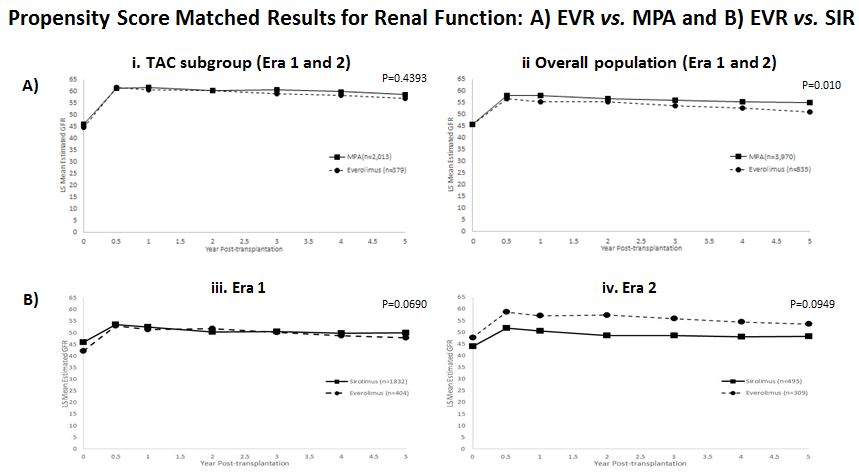Comparison of Long Term Renal Function Outcomes for Everolimus (EVR) vs. Sirolimus (SIR) vs. Mycophenolate Acid (MPA) Immunosuppressive Regimens Post Kidney Transplant (Ktx).
1Hospital do Rim UNIFESP, Sao Paulo, Brazil
2CTI Consulting, Raleigh
3Novartis Pharmaceuticals Corporation, East Hanover
4University of Michigan, Ann Arbo
Meeting: 2017 American Transplant Congress
Abstract number: D88
Keywords: Glomerular filtration rate (GFR), Immunosuppression, Kidney transplantation, Renal function
Session Information
Session Name: Poster Session D: Kidney Immunosuppression: Novel Regimens and Drug Minimization
Session Type: Poster Session
Date: Tuesday, May 2, 2017
Session Time: 6:00pm-7:00pm
 Presentation Time: 6:00pm-7:00pm
Presentation Time: 6:00pm-7:00pm
Location: Hall D1
MPA or mammalian target of rapamycin inhibitors (mTORi [EVR or SIR]) in combination with calcineurin inhibitors (CNI, tacrolimus [TAC] or cyclosporine) are used for maintenance immunosuppression. We compared renal function of post KTx patients receiving EVR vs. SIR vs. MPA maintenance immunosuppression at discharge in combination with a CNI.
This analysis included patients from the United Network for Organ Sharing (UNOS) database who were: first time kidney only transplant recipients, ≥18 years, receiving EVR or SIR or MPA + CNI ± steroids at discharge. Exclusion criteria were: allograft failure prior to discharge, donor organ cold ischemia time >40 hours, transplantation in 2001 or 2008–2009 (when EVR was not used). Treatment selection bias was addressed using risk-adjusted methods. Cohorts were matched based on the propensity score for EVR with a greedy matching algorithm within donor type (living vs. deceased). Two mutually exclusive periods were defined (Era1: 1998–2007 / Era 2: 2010–2014; EVR approved in the US in 2010). Linear mixed effects model evaluated change in estimated glomerular filtration rate (eGFR) over time between cohorts. Two-way interactions of cohort by era evaluated eGFR changes between cohorts. Model-based eGFR estimates over time were adjusted for key residual confounders.
Median follow-up was 8 years. Key donor and recipient characteristics were well matched across each arm. Mean eGFR for EVR vs. MPA up to 5 years post KTx was comparable between both arms when CNI was restricted to TAC (p=0.4393), but in the overall population (ie all patients from both Eras), eGFR at 5 years was slightly higher for the MPA arm (54.8 mL/min vs 51.0 mL/min, p=0.010). The eGFR was comparable for EVR vs. SIR regardless of Era. When CNI was limited to TAC, eGFR was comparable for EVR vs. SIR (p=0.6957).  Long term renal function is similar for EVR- vs. SIR-treated KTx patients, independent of CNI, and for EVR- vs. MPA-TAC-containing regimens.
Long term renal function is similar for EVR- vs. SIR-treated KTx patients, independent of CNI, and for EVR- vs. MPA-TAC-containing regimens.
CITATION INFORMATION: Tedesco H, Irish W, Dharmesh K, Patel D, Cibrik D. Comparison of Long Term Renal Function Outcomes for Everolimus (EVR) vs. Sirolimus (SIR) vs. Mycophenolate Acid (MPA) Immunosuppressive Regimens Post Kidney Transplant (Ktx). Am J Transplant. 2017;17 (suppl 3).
To cite this abstract in AMA style:
Tedesco H, Irish W, Dharmesh K, Patel D, Cibrik D. Comparison of Long Term Renal Function Outcomes for Everolimus (EVR) vs. Sirolimus (SIR) vs. Mycophenolate Acid (MPA) Immunosuppressive Regimens Post Kidney Transplant (Ktx). [abstract]. Am J Transplant. 2017; 17 (suppl 3). https://atcmeetingabstracts.com/abstract/comparison-of-long-term-renal-function-outcomes-for-everolimus-evr-vs-sirolimus-sir-vs-mycophenolate-acid-mpa-immunosuppressive-regimens-post-kidney-transplant-ktx/. Accessed December 14, 2025.« Back to 2017 American Transplant Congress
